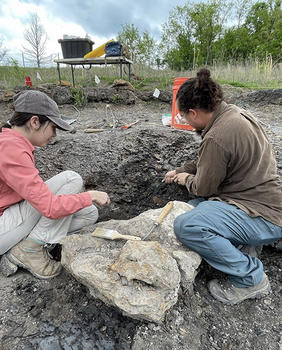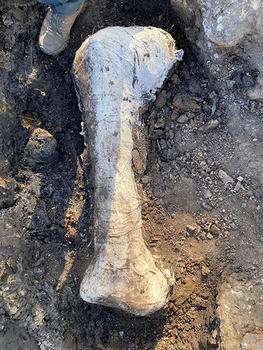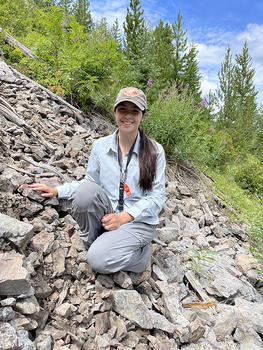Madison Mateo’s family jokes that her passion for paleontology is a dinosaur phase she never outgrew. Now, Mateo is making headlines with the excavation of one of the largest therapod fossils in Eastern America at the M-NCPPC Dinosaur Park in Laurel, Maryland.

Mateo, a Mason undergraduate studying geology with a concentration in paleontology, is a long-time dig site volunteer, starting with geological survey sites in North Dakota when she was in 10th grade. She's been a regular volunteer at M-NCPPC Dinosaur Park since 2021.
“The park is a cool place to talk about what I love—dinosaurs and fossils—while applying what I’m learning in my major,” Mateo said. “Seeing fossils every day, no matter how big or small, and talking to people about them is fun for me.”
M-NCPPC Dinosaur Park is known for both its density and diversity of fossils, making it one of the premier bone beds east of the Mississippi. The park is open to the public twice a month, during which time volunteers like Mateo can help discover new fossils through surface collection techniques.

Hearing about Mateo’s experience with other dig sites, park paleontologist JD Hodnett wanted her to get more involved through visitor education and site excavations. “Madison has been with the bone bed since the beginning,” he said. “She’s been a huge help for us.”
Over the summer, Mateo and fellow volunteer and paleontologist Federico Alvarez Hazer found the groundbreaking fossil during a routine dig and did all the initial work to uncover the bone.
Hodnett suspects the fossil to be a 3-foot-long tibia of an Acrocanthosaurus, the largest theropod of the Early Cretaceous period, and the largest predatory dinosaur in North America until the evolution of the Tyrannosaurus rex in the Late Cretaceous—about 50 million years later. It is the first major find at the park since the 19th century, and the first bone of this species to be discovered in the area. Since the tibia, park paleontologists discovered vertebrae of armored dinosaurs and the remains of a long-necked sauropod.
“We've doubled what we knew about the geological and ecological history of this area in just a few months,” said Hodnett. “This tells a completely different story about dinosaurs in North America than what we originally hypothesized. It’s a huge find.”

Mateo’s work at the M-NCPPC Dinosaur Park has opened doors around the country, such as an invitation to a paleontological resource inventory in Yellowstone and Grand Tetons National Parks with Hodnett and a team of acclaimed paleontologists. While gaining critical hands-on experience, Mateo applies what she’s learning in classes at Mason, from dig techniques to fossil identification.
“Mason’s paleontology program is special in that it’s rare to find an institution that offers degrees in paleontology at both undergraduate and graduate levels,” said Mark D. Uhen, professor of geology and chair of the Department of Atmospheric, Oceanic and Earth Sciences. “Our students have great success in finding internships as well, including with the US Geological Survey and Smithsonian.”
“I get excited for any find, even teeth fragments,” Mateo said, “but being part of this massive find like this was just really cool.”
Related Stories
- November 20, 2025
- November 19, 2025
- November 11, 2025
- November 10, 2025
- October 29, 2025
This content appears in the Spring 2024 print edition of the Mason Spirit Magazine with the title "Mason student helps unearth rare fossil in Maryland."
